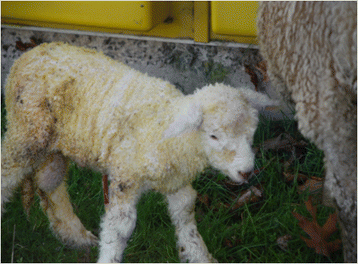Large animal models of rare genetic disorders: sheep as phenotypically relevant models of human genetic disease
- PMID: 26329332
- PMCID: PMC4557632
- DOI: 10.1186/s13023-015-0327-5
Large animal models of rare genetic disorders: sheep as phenotypically relevant models of human genetic disease
Abstract
Animals that accurately model human disease are invaluable in medical research, allowing a critical understanding of disease mechanisms, and the opportunity to evaluate the effect of therapeutic compounds in pre-clinical studies. Many types of animal models are used world-wide, with the most common being small laboratory animals, such as mice. However, rodents often do not faithfully replicate human disease, despite their predominant use in research. This discordancy is due in part to physiological differences, such as body size and longevity. In contrast, large animal models, including sheep, provide an alternative to mice for biomedical research due to their greater physiological parallels with humans. Completion of the full genome sequences of many species, and the advent of Next Generation Sequencing (NGS) technologies, means it is now feasible to screen large populations of domesticated animals for genetic variants that resemble human genetic diseases, and generate models that more accurately model rare human pathologies. In this review, we discuss the notion of using sheep as large animal models, and their advantages in modelling human genetic disease. We exemplify several existing naturally occurring ovine variants in genes that are orthologous to human disease genes, such as the Cln6 sheep model for Batten disease. These, and other sheep models, have contributed significantly to our understanding of the relevant human disease process, in addition to providing opportunities to trial new therapies in animals with similar body and organ size to humans. Therefore sheep are a significant species with respect to the modelling of rare genetic human disease, which we summarize in this review.
Figures
Similar articles
-
Canine and Feline Models of Human Genetic Diseases and Their Contributions to Advancing Clinical Therapies .Yale J Biol Med. 2017 Sep 25;90(3):417-431. eCollection 2017 Sep. Yale J Biol Med. 2017. PMID: 28955181 Free PMC article. Review.
-
GeneYenta: a phenotype-based rare disease case matching tool based on online dating algorithms for the acceleration of exome interpretation.Hum Mutat. 2015 Apr;36(4):432-8. doi: 10.1002/humu.22772. Epub 2015 Mar 19. Hum Mutat. 2015. PMID: 25703386
-
A missense mutation (c.184C>T) in ovine CLN6 causes neuronal ceroid lipofuscinosis in Merino sheep whereas affected South Hampshire sheep have reduced levels of CLN6 mRNA.Biochim Biophys Acta. 2006 Oct;1762(10):898-905. doi: 10.1016/j.bbadis.2006.09.004. Epub 2006 Sep 12. Biochim Biophys Acta. 2006. PMID: 17046213
-
Livestock in biomedical research: history, current status and future prospective.Reprod Fertil Dev. 2016;28(1-2):112-24. doi: 10.1071/RD15343. Reprod Fertil Dev. 2016. PMID: 27062879 Review.
-
Next-generation sequencing applied to rare diseases genomics.Expert Rev Mol Diagn. 2014 May;14(4):469-87. doi: 10.1586/14737159.2014.904749. Epub 2014 Apr 4. Expert Rev Mol Diagn. 2014. PMID: 24702023 Review.
Cited by
-
The Sheep as a Large Animal Model for the Investigation and Treatment of Human Disorders.Biology (Basel). 2022 Aug 23;11(9):1251. doi: 10.3390/biology11091251. Biology (Basel). 2022. PMID: 36138730 Free PMC article. Review.
-
Understanding PACS2 syndrome's pathomechanism by studying E209K and E211K mutations.Mamm Genome. 2025 Jun;36(2):363-371. doi: 10.1007/s00335-024-10098-5. Epub 2024 Dec 30. Mamm Genome. 2025. PMID: 39738582 Review.
-
Induced pluripotent stem cells throughout the animal kingdom: Availability and applications.World J Stem Cells. 2019 Aug 26;11(8):491-505. doi: 10.4252/wjsc.v11.i8.491. World J Stem Cells. 2019. PMID: 31523369 Free PMC article. Review.
-
Targeting Ferroptosis in Rare Neurological Disorders Including Pediatric Conditions: Innovations and Therapeutic Challenges.Biomedicines. 2025 Jan 22;13(2):265. doi: 10.3390/biomedicines13020265. Biomedicines. 2025. PMID: 40002678 Free PMC article. Review.
-
Large Animal Models in Regenerative Medicine and Tissue Engineering: To Do or Not to Do.Front Bioeng Biotechnol. 2020 Aug 13;8:972. doi: 10.3389/fbioe.2020.00972. eCollection 2020. Front Bioeng Biotechnol. 2020. PMID: 32903631 Free PMC article. Review.
References
-
- McKusick-Nathans Institute of Genetic Medicine, Johns Hopkins University School of Medicine (Baltimore MD). Online Mendelian Inheritance of Man, OMIM®. http://www.ncbi.nlm.nih.gov/omim). Accessed 21 March 2014.
Publication types
MeSH terms
LinkOut - more resources
Full Text Sources
Other Literature Sources
Medical


